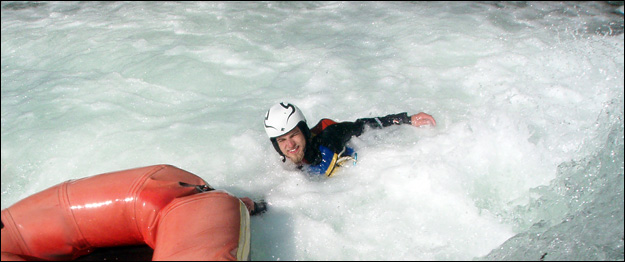
INstructor tips - Weirs
Although many weirs are perfectly safe to slide over or play in the stopper formed at the bottom, many are not. Telling the difference for non-experts is very difficult.
"Weirs are either straightforward or they kill you”
Franco Ferrero - Author Whitewater Safety & Rescue
This statement is born out by the facts, 41 fatalities just from the five largest weir accidents in Europe! Almost all multiple fatalities in rafting, kayaking and canoeing on rivers are due to weirs.
Accidents involving Weirs in Europe
- 2008 - 5 soldiers drown rafting on the Kander river in Switzerland
- 2008 - 13 People drown in a weir while canoeing on the Sava river in Slovenia
- 1999 - 4 UK Tourists drown commercially rafting on the Salzach river in Austria
- 1993 - 9 German Tourists die rafting on the Inn river in Engadine, Switzerland
- 1975 - 10 Soldiers drown at Cromwell Weir on the river Trent in England
So how can we avoid becoming a statistic?
Weirs are so dangerous because even with correct swiftwater rescue training and equipment, if the weir has sufficient towback, it will be almost impossible to self rescue from. Looking at these accidents we can class them into different accident types:
1. Ignorance of the danger
The accidents that occurred on the Kander, Sava and Inn rivers where all, to a large extent, caused by a ignorance of the danger posed by the weirs. Most weirs look very tame compared to sections of whitewater, and the amount of aerated water bears no relation to the amount of towback that will be present. Changes in water level can also account for changes in the amount of towback at a weir. This was the case on the Inn, where the group had successfully run the weir the day before, when less water was flowing.
Ignorance can also mean not knowing that there is a weir (or other deadly feature) on the section of river that you are paddling. In 2010 a party of 4 Russian rafters died in Norway when they put on the wrong section of the Sjoa river, one where the whole river flows through a siphon.
If there is any doubt that a weir (or rapid) is dangerous, then it should always be portaged.
2. Missing the take out
The other two accidents where caused by the rafts missing the take out. On the Trent this was during a military night exercise, on the Salzach when a guest fell out of the raft during landing. This can also be a problem when unrunnable gorges or hard rapids are downstream. Always have everyone look at the take out when there is such a deadly hazard downstream, and get out a good distance above it.
It is far better to walk an extra 200m than miss the last eddy! During night exercises lights positioned to show the end of the exercise area are needed to prevented people continuing downstream and into other hazards.